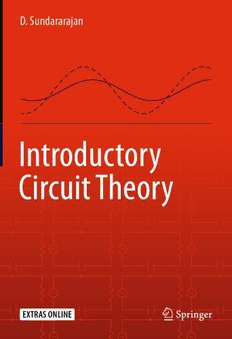
Introductory Circuit Theory PDF
Preview Introductory Circuit Theory
D. Sundararajan Introductory Circuit Theory Introductory Circuit Theory D. Sundararajan Introductory Circuit Theory D.Sundararajan FormerlyatConcordiaUniversity Montreal,QC,Canada Additionalmaterialtothisbookcanbedownloadedfromhttps://Springer.com. ISBN978-3-030-31984-7 ISBN978-3-030-31985-4 (eBook) https://doi.org/10.1007/978-3-030-31985-4 ©SpringerNatureSwitzerlandAG2020 Thisworkissubjecttocopyright.AllrightsarereservedbythePublisher,whetherthewholeorpartofthematerialisconcerned, specificallytherightsoftranslation,reprinting,reuseofillustrations,recitation,broadcasting,reproductiononmicrofilmsorin anyotherphysicalway,andtransmissionorinformationstorageandretrieval,electronicadaptation,computersoftware,orby similarordissimilarmethodologynowknownorhereafterdeveloped. Theuseofgeneraldescriptivenames,registerednames,trademarks,servicemarks,etc.inthispublicationdoesnotimply, evenintheabsenceofaspecificstatement,thatsuchnamesareexemptfromtherelevantprotectivelawsandregulationsand thereforefreeforgeneraluse. Thepublisher,theauthors,andtheeditorsaresafetoassumethattheadviceandinformationinthisbookarebelievedtobe trueandaccurateatthedateofpublication.Neitherthepublishernortheauthorsortheeditorsgiveawarranty,expressedor implied,withrespecttothematerialcontainedhereinorforanyerrorsoromissionsthatmayhavebeenmade.Thepublisher remainsneutralwithregardtojurisdictionalclaimsinpublishedmapsandinstitutionalaffiliations. ThisSpringerimprintispublishedbytheregisteredcompanySpringerNatureSwitzerlandAG. Theregisteredcompanyaddressis:Gewerbestrasse11,6330Cham,Switzerland Preface Circuit theory is fundamental to the study of important engineering applications such as power systems and communication. As such, it forms part of the first course to engineering and science students in several disciplines. This book is written for engineering, computer science and physics students,andengineersandscientists.Boththetheoryandpracticebyprogrammingandinlaboratory aretwoimportantaspectsofthelearningprocessofcircuittheory.Theobjectiveinwritingthisbook is to present the fundamentals of circuit theory systematically in a clear and concise textbook and provide the required programming part online. Hopefully, this approach is expected to improve the readability and understandability of the theory without clutter. Plenty of examples, figures, tables, programs,analogy,andphysicalexplanationsmakeiteasyforthereadertogetagoodgroundingin thebasicsofcircuittheoryandsomeofitsapplications. The learning of the circuit theory requires calculus, linear algebra, transform analysis, program- ming, and laboratory practice. These tools are also required for other courses and in professional careerlater.However,thesetopicsaredifficultfornewstudents.But,throughthemethodssuggested, studentscanlearnwellthisall-importantsubjectwithsufficientpractice.Further,thelearningprocess forthissubjectwillcertainlyhelpthestudentsintheirensuingstudyoftheothersubjects. Learning of the circuit theory consists of four aspects: (1) systematic presentation of the mathematical methods inthe text; (2) verification of the analytically obtained results by coding; (3) verification of the results by simulation; and (4) verification of the results using actual components in laboratory experiments. The last component gives physical appreciation of the circuit elements andtheirvaluesinpractice,thevoltages,currents,frequencies,measuringinstruments,andallother practical aspects involved. Students must take a coordinated laboratory course. Both coding and simulationoftheanalysisofcircuitsarepresentedintheonlineprogrammingpart.Eachstudentcan practiceusingthesefourmethodsasmuchasitisrequiredforagoodunderstandingofthesubject. Thisbookisintendedtobeatextbookforthefirstcourseincircuittheorytothenewundergraduate studentsinseveraldisciplinesofengineeringandscience,whichincludestheprimarydisciplinesof electricalandelectronicsengineering.Forengineeringprofessionals,thisbookwillbeusefulforself- study. In addition, this book will be a reference for anyone, student or professional, specializing in practicalapplicationsofcircuittheory.Theprerequisiteforreadingthisbookisagoodknowledgeof physicsandcalculusatthehighschoollevel. Asmentionedalready,programmingisanimportantcomponentinlearningandpracticingcircuit theory, as well as other subjects. While several software packages are available, it is better to use a popular general-purpose software package that the students are likely to use in their other courses and ensuing professional carrier in several areas of engineering and science. Therefore, learning of only one package is required. The programming part is presented using the popular, user-friendly (cid:2) and widely used, both in universities and industries, MATLABR software package. While the use ofasoftwarepackageisinevitableinmostapplications,itisbettertousethesoftwareinadditionto v vi Preface self-developedprograms.Theeffectiveuseofasoftwarepackageortodevelopownprogramsrequires agoodgroundinginthebasicprinciplesofthecircuittheory.Answerstoselectedexercisesmarked ∗aregivenattheendofthebook.ASolutionsManualandslidesareavailableforinstructorsatthe websiteofthebook. Iassumetheresponsibilityforalltheerrorsinthisbookandwouldverymuchappreciatereceiving readers’ suggestions and pointing out any errors (email:[email protected]). I am grateful tomyEditorandtherestoftheteamatSpringerfortheirhelpandencouragementincompletingthis project.Ithankmyfamilyfortheirsupportduringthisendeavor. D.Sundararajan Contents 1 BasicConcepts................................................................ 1 1.1 Ohm’sLaw .............................................................. 3 1.2 ResistorsConnectedinSeries............................................... 4 1.3 ResistorsConnectedinParallel.............................................. 7 1.4 ResistorsConnectedinSeriesandParallel .................................... 9 1.5 Kirchhoff’sVoltageandCurrentLaws........................................ 11 1.6 Applications ............................................................. 13 1.7 Summary................................................................ 13 2 DCCircuits .................................................................. 19 2.1 MeshAnalysis ........................................................... 20 2.2 NodalAnalysis ........................................................... 27 2.3 Examples................................................................ 29 2.3.1 LinearityPropertyofCircuits......................................... 37 2.3.2 AnalysisofaCircuitwithaControlledVoltageSource ................... 40 2.3.3 AnalysisofaCircuitwithaControlledCurrentSource ................... 44 2.3.4 Y −(cid:2)and(cid:2)−Y Transformations.................................... 55 2.4 CircuitTheorems ......................................................... 59 2.4.1 Thévenin’sTheoremandNorton’sTheorem............................. 59 2.4.2 MaximumPowerTransferTheorem ................................... 65 2.5 Application .............................................................. 67 2.5.1 StrainGaugeMeasurement........................................... 67 2.6 Summary................................................................ 68 3 ACCircuits................................................................... 77 3.1 Sinusoids................................................................ 77 3.1.1 TheRectangularFormofSinusoids.................................... 79 3.1.2 TheComplexSinusoids ............................................. 79 3.2 ACCircuitAnalysis....................................................... 80 3.2.1 Time-andFrequency-DomainRepresentationsofCircuitElements ......... 80 3.2.2 Time-DomainAnalysisofaSeriesRCCircuit........................... 82 3.2.3 Frequency-DomainAnalysisofaRCCircuit............................ 84 3.2.4 ImpedancesConnectedinSeries ...................................... 85 3.2.5 ImpedancesConnectedinParallel..................................... 91 3.2.6 ImpedancesConnectedinSeriesandParallel............................ 93 3.2.7 AnalysisofTypicalCircuits .......................................... 94 3.2.8 LinearityPropertyofCircuits......................................... 105 vii viii Contents 3.3 CircuitTheorems ......................................................... 122 3.3.1 Thévenin’sTheorem ................................................ 122 3.3.2 Norton’sTheorem .................................................. 130 3.3.3 MaximumAveragePowerTransferTheorem............................ 131 3.3.4 SourceTransformation .............................................. 133 3.4 Application .............................................................. 135 3.4.1 Filters ............................................................ 135 3.5 Summary................................................................ 137 4 Steady-StatePower............................................................ 149 4.1 EnergyinReactiveElementswithSinusoidalSources........................... 150 4.2 PowerRelationsinaCircuit ................................................ 151 4.3 Power-FactorCorrection ................................................... 159 4.4 Application .............................................................. 173 4.5 Summary................................................................ 173 5 MagneticallyCoupledCircuits.................................................. 177 5.1 MutualInductance ........................................................ 177 5.2 StoredEnergy ............................................................ 178 5.3 Examples................................................................ 181 5.4 Application .............................................................. 198 5.4.1 Transformers ...................................................... 198 5.5 Summary................................................................ 199 6 Three-PhaseCircuits .......................................................... 203 6.1 Three-PhaseVoltages...................................................... 203 6.1.1 TheInstantaneousPower ............................................ 205 6.2 TheThree-PhaseBalancedY −Y Circuit..................................... 205 6.3 TheThree-PhaseBalancedY −(cid:2)Circuit..................................... 207 6.4 TheThree-PhaseBalanced(cid:2)−Y Circuit..................................... 210 6.5 TheThree-PhaseBalanced(cid:2)−(cid:2)Circuit .................................... 211 6.6 Application .............................................................. 212 6.7 Summary................................................................ 212 7 Two-PortNetworks............................................................ 215 7.1 ImpedanceParameters..................................................... 215 7.2 AdmittanceParameters .................................................... 221 7.3 HybridParameters ........................................................ 224 7.4 TransmissionParameters................................................... 225 7.5 Examples................................................................ 226 7.5.1 Analysisofaπ Circuit .............................................. 226 7.5.2 AnalysisofaCommon-EmitterTransistorAmplifier ..................... 228 7.5.3 AnalysisofaBridgeCircuit.......................................... 230 7.5.4 LadderCircuit ..................................................... 231 7.6 Application .............................................................. 233 7.6.1 Digital-to-AnalogConverter:TheR−2RLadderCircuit ................. 233 7.7 Summary................................................................ 236 Contents ix 8 TransformAnalysisandTransientResponse ..................................... 239 8.1 FourierSeries ............................................................ 240 8.1.1 FourierSeriesofaRectifiedSineWave ................................ 242 8.1.2 GibbsPhenomenon ................................................. 246 8.2 FourierTransform ........................................................ 246 8.2.1 TheTransferFunctionandtheFrequencyResponse ...................... 248 8.3 TransientResponse........................................................ 249 8.3.1 TheUnit-ImpulseandUnit-StepSignals................................ 250 8.4 LaplaceTransform ........................................................ 252 8.4.1 PropertiesoftheLaplaceTransform ................................... 253 8.4.2 Time-Differentiation ................................................ 254 8.4.3 Integration ........................................................ 254 8.4.4 InitialValue ....................................................... 255 8.4.5 FinalValue ........................................................ 255 8.4.6 CircuitAnalysisintheFrequency-Domain.............................. 255 8.5 Application .............................................................. 269 8.6 Summary................................................................ 271 A Matrices ..................................................................... 275 A.1 Determinants............................................................. 277 B ComplexNumbers ............................................................ 281 AnswerstoSelectedExercises...................................................... 285 Bibliography .................................................................. 291 Index ........................................................................... 293 Abbreviations AC Alternatingcurrent,sinusoidallyvaryingcurrentorvoltage DC Directcurrent,sinusoidwithfrequencyzero,constantcurrentorvoltage FS Fourierseries FT Fouriertransform Im Imaginarypartof KCL Kirchhoff’sCurrentLaw KVL Kirchhoff’sVoltageLaw LTI Lineartime-invariant pf Powerfactor RC Circuitcomprisingaresistorandacapacitorinseries Re Realpartof RL Circuitcomprisingaresistorandaninductorinseries RLC Circuitcomprisingaresistor,acapacitor,andaninductorinseries RMS Root-mean-squarevalue xi
